Abstract
Background:
The knowledge and skills about the basic life support (BLS) and the advanced life support are the most important determining factors of the cardiopulmonary resuscitation (CPR) success rates. Objectives: To determine the level of awareness on BLS and skills among undergraduate and postgraduate students of medical and dental profession, as well as nursing students and interns in a tertiary care hospital.
Materials and Methods:
This descriptive cross-sectional study was conducted in a tertiary care hospital in South India. The awareness level on BLS and factors associated which include age, sex, level of training (undergraduate, internship, and postgraduate groups), course of study (nursing, dental, and medical groups), and previous exposure to BLS were assessed by using a structured questionnaire. The association of these variables with awareness level was assessed by independent t test, analysis of variance, and linear regression analysis.
Results:
Among 520 study subjects, 229 were students, 171 were interns, and 120 were postgraduate students. The overall mean score of awareness was 4.16 ± 1.40 (score range: 0-10). Age, sex, level of training, course of study, and previous exposure to BLS were significantly associated with awareness level in univariate analysis (P < 0.05). Linear regression model also showed that all the above variables were significantly associated with awareness level (P < 0.05). About 322 (61.9%) subjects attributed lack of awareness about BLS to lack of available professional training. About 479 (92.1%) responded that BLS training should be a part of medical curriculum.
Conclusion:
Awareness level on BLS is below average indicating the importance of professional training at all levels in a tertiary care health institution.
Keywords: Awareness, basic life support (BLS), BLS, cardio-pulmonary resuscitation (CPR), CPR, India
INTRODUCTION
Basic life support (BLS) and advanced cardiac life support (ACLS) are part of cardiopulmonary resuscitation (CPR).[1] Over time, resuscitation skills have evolved into a proper protocol, which involves CPR commonly known as BLS. Invented in 1960, CPR is a simple but effective procedure that allows almost anyone to sustain life in the early critical minutes after cardiac and respiratory arrest. BLS includes both prompt recognition and immediate support of ventilation and circulation in case of respiratory or cardiac arrest.[2] It has a combination of skills including support to ventilation and chest compression to normalize blood circulation to the brain and vital organs. Knowledge of BLS and practice of simple CPR techniques ensures the survival of the patient long enough till experienced medical help arrives and in most cases is itself sufficient for survival.[3] Proper practice of the techniques and manoeuvres enables a person to effectively resuscitate a victim. Ideally, everyone should know BLS and CPR but its awareness to medical personnel is invaluable. Newly qualified doctors are expected to take part in resuscitation from their first day.[3]
In India, very little data are present which addresses the awareness of the medical personnel including students, doctors, and paramedical staff regarding this highly effective and easy manoeuvre. Such studies will be useful to understand the prerequisites for forming guidelines in this regard. The objective of this study was to determine the level of awareness regarding BLS and knowledge of involved skills among undergraduate and postgraduate students of medical and dental profession, as well as nursing students and interns in a tertiary care hospital.
MATERIALS AND METHODS
Setting
It was a descriptive cross-sectional study conducted at K. S. Hegde Medical and Dental College Hospital and Nursing College during April-June 2013.
Sample size estimation and sampling technique
By considering the proportion of awareness level as 50%[4] and relative precision at 5% level, minimum sample size required was found to be 400. After adding 10% nonrespondents, total minimum sample size became 440. The subjects were selected proportionally from each category of course and all the subjects in the randomly selected class groups were included. This yielded a final sample size of 534.
Method of data collection
A structured questionnaire was used to assess the levels of awareness, its practical knowledge, and attitude toward BLS. The aspects interrogated were about the abbreviation of BLS, ACLS, EMS (Emergency Medical Services), AED (Automated External Defibrillator); and the process and its requirements. It also covered about the awareness on skills and the knowledge of CPR. Previous experiences and exposure to BLS training as well as the attitude towards BLS were also assessed.
The institutional ethical clearance was taken before the study. A total sample of 534 subjects were included and asked to fill up the questionnaires. The study covered undergraduate and postgraduate students of medical and dental profession, as well as nursing students and interns. The study group was divided based on age, sex, level of training (undergraduate, internship, and postgraduate groups), the course of study (nursing, dental, and medical groups), and whether they had any previous exposure to BLS.
Data analysis
Analysis of the results was done using SPSS version 16.0. The analysis for association of these variables with awareness about BLS between these groups was done by independent t test, analysis of variance, and linear regression model. The results were tabulated and compared between these groups. P value less than 0.05 is considered as significant.
RESULTS
Out of 534 subjects, 520 completed the questionnaire and were included for analysis. A total of 229 were students, 171 were interns, and 120 were postgraduate students [Figure 1]. And 122 study subjects were from nursing college, 197 were from dental college, and 201 were from medical college. A total of 332 study participants were females and 188 study participants were males.
Figure 1.
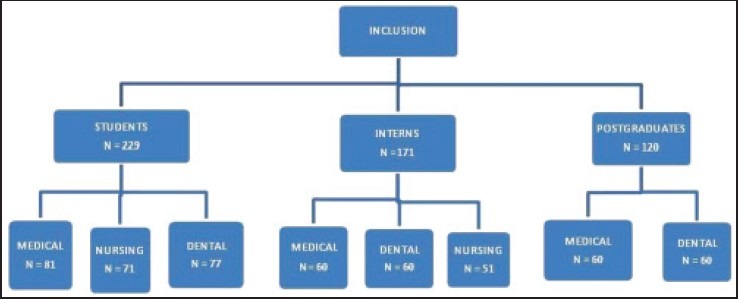
Distribution of study participants
The mean score with regard to awareness of BLS and other general aspects of emergency medical services was 2.94 ± 0.90 with a score range of 0-6. The mean score of the knowledge about the skills of BLS in the study group was 1.22 ± 0.91 with a score range of 0-4. The overall mean score regarding the awareness was 4.16 ± 1.40 (score range 0-10) [Table 1]. Among 520 study subjects, 496 (95.4%) had heard about BLS in the past. Also, 513 (98.7%) felt that it is useful to know about BLS/ACLS. Only 76 (14.6%) had heard about EMS, and 59 (11.3%) could expand AED. Only 89 (17.1%) answered that BLS is not mandatory to be done in the hospital setting. A total of 293 (56.3%) were aware of the number to be dialled to call for help in case of a medical emergency in our set up [Table 2].
Table 1.
Awareness level of study subjects

Table 2.
Awareness on basic life support (N = 520)
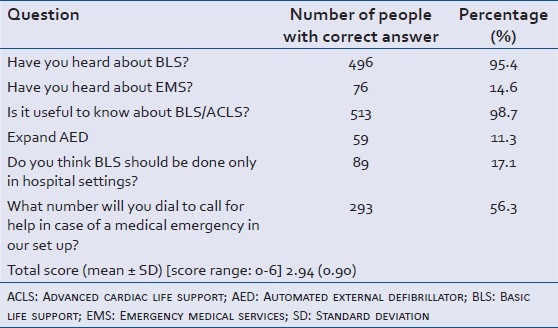
A total of 178 (34.2%) responded correctly regarding the number of chest compression in one minute, whereas 212 (40.8%) could answer the ratio of chest compressions to breaths in an adult. And 182 (35%) answered correctly about the location of chest compression and only 56 (10.8%) could arrange a. Airway, b. Breathing, and c. Chest compression in orderly sequence [Table 3]. Age, sex, level of training, course, and previous exposure to BLS was significantly associated with awareness level in univariate analysis [Table 4]. Linear regression model also showed that all the above variables were significantly associated with awareness level (P < 0.05) [Table 5]. A total of 489 (94%) answered positively for the question “Does everybody need to know about BLS?” 479 (92.1%) responded that BLS training should be a part of medical curriculum. And 135 (26%) attributed lack of awareness about BLS to busy curriculum and 63 (12.1%) to lack of interest and 322 (61.9%) to lack of professional training available.
Table 3.
Awareness about the skills of basic life support (N = 520)
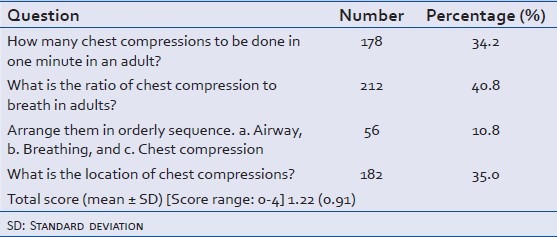
Table 4.
Association of awareness level about basic life support with associated factors (N = 520)
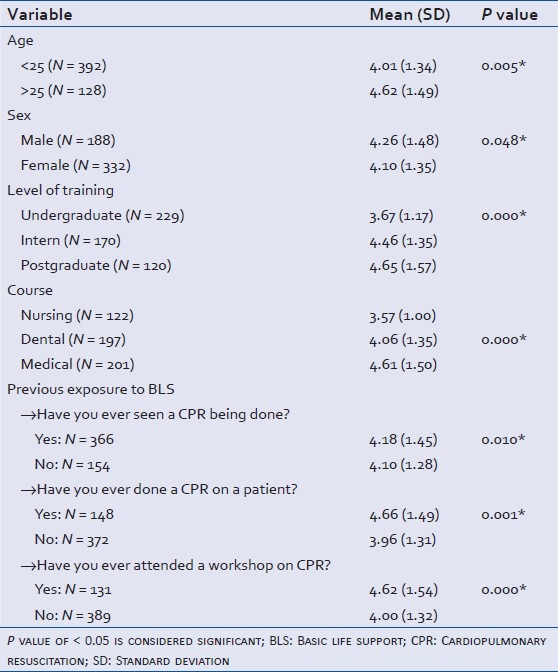
Table 5.
Association of awareness level: Linear regression model
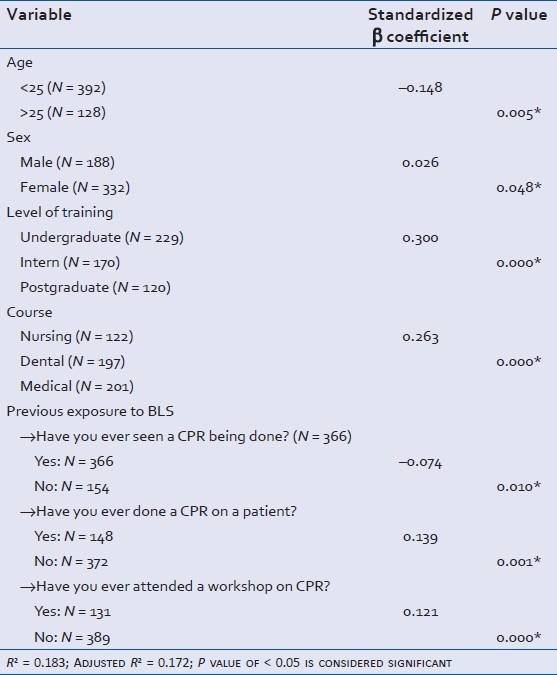
DISCUSSION
The study was done to determine the level of awareness regarding BLS and knowledge of involved skills among undergraduate and postgraduate students of medical and dental profession, as well as nursing students and interns in a tertiary care hospital. The mean score about the awareness of BLS and other general aspects of emergency medical services was 2.94 ± 0.90 with a score range of 0-6. Though 513 (98.7%) study subjects felt that it is useful to know about BLS, the awareness about other aspects was poor. Only 76 (14.6%) had heard about EMS and only 59 (11.3%) could expand AED. A total of 89 (17.1%) felt that BLS should be done in hospital setting.
The mean score of the knowledge about the skills of BLS in the study group was 1.22 ± 0.91 with a score range of 0-4. A total of 178 (34.2%) answered correctly about the number of chest compressions to be done in one minute in an adult and 212 (40.8%) replied positively about the ratio of chest compression to breath in adults. Also, about 1/3rd (182; 35%) replied correctly regarding the location of chest compressions. But, only 56 (10.8%) were able to arrange a. Airway, b. Breathing, and c. Chest compression in orderly sequence. This is because of the fact that majority of the study subjects were not aware of the recent change of A-B-C sequence to C-A-B as per AHA 2010 guidelines.
The overall mean score regarding the awareness was 4.16 ± 1.40 (score range 0-10). This indicates that the average score among the study subjects was < 50%. In another study from South India, the awareness about BLS among students, doctors, and nurses was found to be poor with 84.82% scoring less than 50% marks.[4] This study has shown a serially increasing overall mean score from students to interns and then residents. Similar increments were observed among study subjects across nursing, dental, and medical course. Also, the score was higher in those who have done a CPR rather than just seen a CPR, and it was even more among those who had attended a workshop on CPR previously. But, the mean score in any of these groups was less than 50%.
A recent study conducted in Pakistan revealed that though the knowledge of trained students was higher than the untrained students; reinforcement and refreshing courses are necessary for better level of answering.[5] Healthcare professionals need to have hands-on practice regularly in order to retain the skills.[6,7] Abbas et al.,[8] showed that knowledge of trained student was found to be better than untrained student. The permanent training program in BLS and ALS resulted in important increment in the level of knowledge of nursing professionals.[9] Another study from Malaysia which studied the knowledge, attitude, and confidence of adult CPR among junior doctors in which about 2/3rd (68.8%) participants had undergone BLS training showed that junior doctors lacked the much needed confidence when it comes to an actual resuscitation case.[10] Despite obvious enthusiasm and self-declared adequate knowledge, 45.7% of the audited students were not familiar with the guidelines and answered wrongly to more than 6 of 12 questions in the questionnaire and vast majority of the first year medical students were not familiar with the algorithms.[11]
The reasons attributed for lack of awareness about BLS in this study included lack of available professional training (322, 61.9%), busy curriculum (135, 26%), and lack of interest (63, 12.1%). A large number of study participants (92.1%) were of the opinion that training of BLS should be a part of the undergraduate curriculum. Though the study included medical and dental students, interns and residents as well as nursing students and interns, the practical skills of BLS is not assessed in this study. This limitation is because of the fact that it is a questionnaire-based study.
CONCLUSION
The study highlights that the awareness level regarding BLS among medical, dental, and nursing students, interns and residents is below average. This issue needs to be addressed promptly. BLS and other resuscitation skills should be a part of the undergraduate curriculum and students should master the skills during their studies. It is recommended that the course should not only be included, regular refreshing courses are necessary with hands on experience.
Footnotes
Source of Support: Nil.
Conflict of Interest: None declared.
REFERENCES
- 1.Robert A Berg, 2010 American heart association guidelines for Cardiopulmonary resuscitation and Emergency Cardiovascular Care Science. Circulation. 2010;122:5685–705. [Google Scholar]
- 2.Phillips PS, Nolan JP. Training in basic and advanced life support in UK medical schools: Questionnaire survey. BMJ. 2001;323:22–3. doi: 10.1136/bmj.323.7303.22. [DOI] [PMC free article] [PubMed] [Google Scholar]
- 3.Steen PA, Kramer-Johansen J. Improving cardiopulmonary resuscitation quality to ensure survival. Curr Opin Crit Care. 2008;14:299–304. doi: 10.1097/MCC.0b013e3282f827d3. [DOI] [PubMed] [Google Scholar]
- 4.Chandrasekharan S, Kumar S, Bhat SA, Saravanakumar, Shabbir PM, Chandrasekharan V. Awareness of basic life support among medical, dental, nursing students and doctors. Indian J Anaest. 2010;54:121–6. doi: 10.4103/0019-5049.63650. [DOI] [PMC free article] [PubMed] [Google Scholar]
- 5.Abbas A, Bukhari SI, Ahmad F. Knowledge of first aid and basic life support amongst medical students: A comparison between trained and untrained students. J Pak Med Assoc. 2011;61:613–6. [PubMed] [Google Scholar]
- 6.Farah R, Stiner E, Zohar Z, Zveibil F, Eisenman A. Cardiopulmonary resuscitation surprise drills for assessing, improving and maintaining cardiopulmonary resuscitation skills of hospital personnel. Eur J Emerg Med. 2007;14:332–6. doi: 10.1097/MEJ.0b013e328285d6d6. [DOI] [PubMed] [Google Scholar]
- 7.Morgan R, Westmoreland C. Survey of junior hospital doctors’ attitudes to cardiopulmonary resuscitation. Postgrad Med J. 2002;78:413–5. doi: 10.1136/pmj.78.921.413. [DOI] [PMC free article] [PubMed] [Google Scholar]
- 8.Asad A, Bukhari SI, Ahmad F. Knowledge of first aid and basic life support amongst medical students: A comparison between trained and untrained students. J Pak Med Assoc. 2011;61:613–6. [PubMed] [Google Scholar]
- 9.Lima SG, Macedo LA, Vidal Mde L, Sá MP. Permanent Education in BLS and ACLS: Impact on the knowledge of nursing professionals. Arq Bras Cardiol. 2009;93:582–8. doi: 10.1590/s0066-782x2009001200012. [DOI] [PubMed] [Google Scholar]
- 10.Chew FZ, Mohd Hashairi F, Ida Zarina Z, Shaik Farid AW, Abu Yazid MN, Nik Hisamuddin NA. A survey on the Knowledge, Attitude and Confidence Level of Adult Cardiopulmonary Resuscitation Among Junior Doctors in Hospital Universiti Sains Malaysia And Hospital Raja Perempuan Zainab II, Kota Bharu, Kelantan, Malaysia. Med J Malaysia. 2011;66:56–9. [PubMed] [Google Scholar]
- 11.Chojnacki P, Ilieva R, Kołodziej A, Królikowska A, Lipka J, Ruta J. Knowledge of BLS and AED resuscitation algorithm amongst medical students--preliminary results. Anestezjol Intens Ter. 2011;43:29–32. [PubMed] [Google Scholar]


